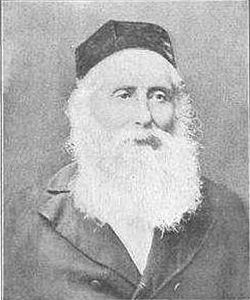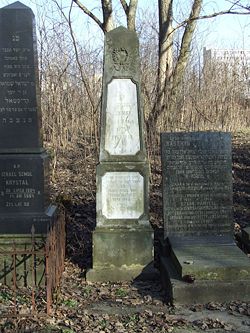- Hayyim Selig Slonimski
-
Hayyim Selig Slonimski (Polish: Chaim Zelig Słonimski) (1810–1904) was a Hebrew publisher, astronomer, inventor, and science author.
Contents
Biography
Hayyim Selig Slonimski was born in Byelostok, Russian Empire (modern Białystok, Poland) March 31, 1810.
When Slonimski was only twenty-four years old he finished writing a textbook on mathematics, but due to lack of funds, only the first part of which was published in 1834 under the title Mosede Ḥokmah.[1]
In 1835 Slonimski released Sefer Kukba di-Shebit (1835), a collection of essays on the Halley comet and other astronomy related topics such as laws of Kepler and Newton. This work significantly increased Slonimiski's popularity, because Halley's comet was widely discussed topic as the return of this periodic comet was expected in 1835.[2]
In 1838 Hayyim Selig Slonimski settled in Warsaw, where he became acquainted with mathematician and inventor Abraham Jacob Stern (1768–1842), later becoming his son-in-law, when in 1842 he married Stern's youngest daughter, Sarah (1824–1897).
In 1844 he was awarded the part Demidov Prize of 2,500 rubles by Russian Academy of Sciences for the invention of a calculating machine.[3] Slonimski lived between 1846 and 1858 in Tomaszów Mazowiecki, an industrial town in central Poland. In 1853 he invented a chemical process for plating iron vessels with lead, and in 1856 an electrochemical device for sending quadruple telegrams. The system of multiple telegraphy perfected by Lord Kelvin in 1858 was based on Slonimski's discovery [4]
In deciding certain scientific questions connected with Jewish matters, Slonimski at times found himself at variance with other Jewish scholars. Thus, despite his conservatism, he admitted that an error of four days' excess had crept into the Hebrew calendar cycle as compared with the true solar cycle; in this view he was opposed especially by Joseph Perles, the controversy being carried on for thirty years. Slonimski likewise discussed the question of the so-called "Jewish date-line" for deciding on which days Shabbat and holy days should be observed by Jews in the Far East and in Australasia. He argued that for them the line must be fixed not from Greenwich, but from Jerusalem, the center of the earth according to the Talmud. This calculation would make the dividing line pass between China and Japan, the former with the Philippines being included in the Far East, and the latter in the West .[4]
In 1862 in Warsaw Slonimski established weekly newspaper Ha-Tsefirah, which was the first Hebrew organ devoted mainly to scientific subjects.[5][4] It was published for six months until the same year Slonimski was appointed as principal of the rabbinical seminary in Zhytomyr and as government censor of Hebrew books, positions which he held till the seminary was closed by the Russian government in 1874 .[4]
Slonimski resumed the publication of Ha-Tsefirah at Berlin the same year, changing the place of publication to Warsaw in September 1875.
Hayyim Selig Slonimski died in Warsaw on May 15, 1904.
Major works
- Mosede Ḥokmah (1834), on the fundamental principles of higher algebra
- Sefer Kukba di-Shebit (1835), essays on the Halley comet and on astronomy in general
- Toledot ha-Shamayim (1838), on astronomy and optics
- Yesode ha-'Ibbur (1852), on the Jewish calendar system and its history
- Meẓi'ut ha-Nefesh we-Ḳiyyumah (1852), on of the immortality of the soul
- Ot Zikkaron (1858), a biographical sketch of Alexander von Humboldt
References
 This article incorporates text from the 1901–1906 Jewish Encyclopedia article "Slonimski, Ḥayyim Selig" by Isidore Singer and Judah David Eisenstein, a publication now in the public domain.
This article incorporates text from the 1901–1906 Jewish Encyclopedia article "Slonimski, Ḥayyim Selig" by Isidore Singer and Judah David Eisenstein, a publication now in the public domain.
- ^ Israel Zinberg (1978) The Haskalah Movement in Russia, p.180
- ^ Israel Zinberg, The Haskalah Movement in Russia, p.180
- ^ Chaim Aronson, Norman Marsden (1983) A Jewish Life Under the Tsars: The Autobiography of Chaim Aronson, 1825–1888 Oxford Centre for Postgraduate Hebrew Studies, p.310
- ^ a b c d JewishEncyclopedia.com - SLONIMSKI, ḤAYYIM SELIG: at www.jewishencyclopedia.com
- ^ Israel Zinberg The Haskalah Movement in Russia, p. 179. "The basic purpose of Ha-Tzefirah", Slonimski <...> announced in the prospectus of the journal which he circulated in January 1862,"is to spread the light of the necessary sciences, to demonstrate their beauty and utility".
External links
Categories:- 1810 births
- 1904 deaths
- Russian inventors
- Polish inventors
- Jewish scholars
- Jewish writers
- Demidov Prize laureates
- People from Białystok
- People from Tomaszów Mazowiecki
- Jewish inventors
- Polish mathematicians
- Polish Jews
- Orthodox Jewish scientists
- Polish Orthodox Jews
- Russian Orthodox Jews
Wikimedia Foundation. 2010.


